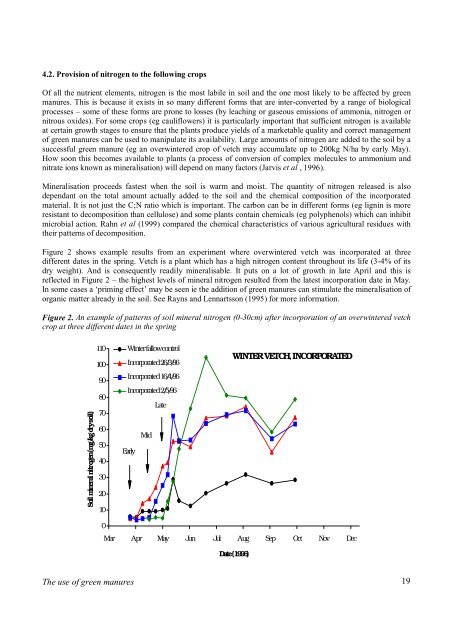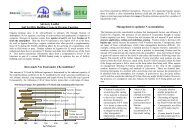Green Manures booklet - Institute of Organic Training and Advice
Green Manures booklet - Institute of Organic Training and Advice
Green Manures booklet - Institute of Organic Training and Advice
Create successful ePaper yourself
Turn your PDF publications into a flip-book with our unique Google optimized e-Paper software.
4.2. Provision <strong>of</strong> nitrogen to the following crops<br />
Of all the nutrient elements, nitrogen is the most labile in soil <strong>and</strong> the one most likely to be affected by green<br />
manures. This is because it exists in so many different forms that are inter-converted by a range <strong>of</strong> biological<br />
processes – some <strong>of</strong> these forms are prone to losses (by leaching or gaseous emissions <strong>of</strong> ammonia, nitrogen or<br />
nitrous oxides). For some crops (eg cauliflowers) it is particularly important that sufficient nitrogen is available<br />
at certain growth stages to ensure that the plants produce yields <strong>of</strong> a marketable quality <strong>and</strong> correct management<br />
<strong>of</strong> green manures can be used to manipulate its availability. Large amounts <strong>of</strong> nitrogen are added to the soil by a<br />
successful green manure (eg an overwintered crop <strong>of</strong> vetch may accumulate up to 200kg N/ha by early May).<br />
How soon this becomes available to plants (a process <strong>of</strong> conversion <strong>of</strong> complex molecules to ammonium <strong>and</strong><br />
nitrate ions known as mineralisation) will depend on many factors (Jarvis et al , 1996).<br />
Mineralisation proceeds fastest when the soil is warm <strong>and</strong> moist. The quantity <strong>of</strong> nitrogen released is also<br />
dependant on the total amount actually added to the soil <strong>and</strong> the chemical composition <strong>of</strong> the incorporated<br />
material. It is not just the C;N ratio which is important. The carbon can be in different forms (eg lignin is more<br />
resistant to decomposition than cellulose) <strong>and</strong> some plants contain chemicals (eg polyphenols) which can inhibit<br />
microbial action. Rahn et al (1999) compared the chemical characteristics <strong>of</strong> various agricultural residues with<br />
their patterns <strong>of</strong> decomposition.<br />
Figure 2 shows example results from an experiment where overwintered vetch was incorporated at three<br />
different dates in the spring. Vetch is a plant which has a high nitrogen content throughout its life (3-4% <strong>of</strong> its<br />
dry weight). And is consequently readily mineralisable. It puts on a lot <strong>of</strong> growth in late April <strong>and</strong> this is<br />
reflected in Figure 2 – the highest levels <strong>of</strong> mineral nitrogen resulted from the latest incorporation date in May.<br />
In some cases a ‘priming effect’ may be seen ie the addition <strong>of</strong> green manures can stimulate the mineralisation <strong>of</strong><br />
organic matter already in the soil. See Rayns <strong>and</strong> Lennartsson (1995) for more information.<br />
Figure 2. An example <strong>of</strong> patterns <strong>of</strong> soil mineral nitrogen (0-30cm) after incorporation <strong>of</strong> an overwintered vetch<br />
crop at three different dates in the spring<br />
Soil mineral nitrogen (mg/kg dry soil)<br />
110<br />
100<br />
90<br />
80<br />
70<br />
60<br />
50<br />
40<br />
30<br />
20<br />
10<br />
Early<br />
The use <strong>of</strong> green manures<br />
0<br />
Winter fallow control<br />
Incorporated 26/3/96<br />
Incorporated 16/4/96<br />
Incorporated 2/5/96<br />
Mid<br />
Late<br />
WINTER VETCH, INCORPORATED<br />
Mar Apr May Jun Jul Aug Sep Oct Nov Dec<br />
Date (1996)<br />
19




